Intro: Singapore is a traditionally conservative Asian country, known for its stringent laws. But it’s also one of the top economic and technological ‘tigers’ of the twenty-first century. The clash of these two forces, old and new, is slowly but surely bringing change for the better for lesbigays here.
Also see:
Gay Singapore Stories
Gay Singapore News & Reports 2000 to present
Gay Singapore Photo Galleries
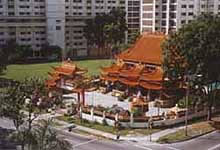
By Richard Ammon
October 1996
Updated March 2006
Young and Fit
Roland has just emerged from his gym feeling buffed and tired, dressed again in his dark business suit except for the conservative necktie. He leaves the shiny marble facility and heads out into the bustle of Orchard Road, Singapore’s intensely trendy and upscale avenue of fashion and cuisine.
For the past hour and a half his prescribed workout has included the usual heavy metal as well as the chrome step/walk machines–with a Walkman for background music. Gym time has become a part of his routine since he started working in his native Singapore as a young professional seven years ago.
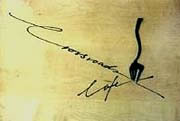 Along with countless other mostly young Singaporeans, he meets friends at the Crossroads Cafe on the ground floor of the towering pagoda-like Marriott Hotel. After dinner, they move to a local mixed/gay bar for a drink and later part ways in the immaculate subway. Roland heads home to the high rise flat where he lives with his parents and a brother.
Along with countless other mostly young Singaporeans, he meets friends at the Crossroads Cafe on the ground floor of the towering pagoda-like Marriott Hotel. After dinner, they move to a local mixed/gay bar for a drink and later part ways in the immaculate subway. Roland heads home to the high rise flat where he lives with his parents and a brother.
Roland appears as the standard image of an efficient, well-groomed middle class young Singaporean professional (of Chinese descent) who is absorbed in the commercial and social fabric of this city-state of 2.5 million people. Signs of health and affluence are awash in the clean streets and marble skyscrapers: plentiful food, clean water, sparkling new shopping malls, good air quality, a busy harbor, fine clothes and low unemployment. Roland lives the compliant ‘good life’ here and offers few complaints about his life in general.
Problems with the Boyfriend
But among the trends and polish, there is a problem that he can’t solve too easily: his American-born boyfriend doesn’t like the way Roland dresses when they go out dancing on Sundays at Music World, the once-a-week gay disco housed in a former theatre.
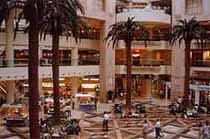 The two men have been dating for about a year and the increased familiarity has of course drawn out deeper personality issues which they argue about and try to solve on their own. Barry thinks Roland looks ‘too gay’ when he dresses for dancing. Roland thinks Barry is too insecure and homophobic which spoils the fun when they are together. The issues are separating them.
The two men have been dating for about a year and the increased familiarity has of course drawn out deeper personality issues which they argue about and try to solve on their own. Barry thinks Roland looks ‘too gay’ when he dresses for dancing. Roland thinks Barry is too insecure and homophobic which spoils the fun when they are together. The issues are separating them.
However, the choice of going to a counselor is not open to them because there are no gay or gay-oriented therapists in Singapore–as far as Roland knows–and certainly not one for gay couples. More deeply, asking for psychological help in this culture signifies a shameful personal condition that few are willing to admit. So, for now, Roland plans to muddle along by burying his frustration and focusing on the rest of his relationship with Barry. "We get along with each other when we’re alone, and when we’re in bed," he confesses with a slightly embarrassed laugh, "but that’s not so often because I still live with my family."
Signs and images
As Roland and I sit together at dinner and talk, he looks out onto the passing stream of well-dressed pedestrians. "You see that guy over there in the green shirt? He’s here every day at this time. I see him at the gym and then he comes here to cruise."
Such a comment would be unremarkable to most western gay visitors. Cruising happens everywhere. But as we watch the young man ‘work’ his corner (Roland thinks he might be a hustler), he acts as cavalier yet sultry as any denizen of Santa Monica Blvd in L.A.
We had been talking about Singapore and the scene here for gay people. There were changes happening. "That’s what is new here," Roland pointed out, "five years ago he would have been too scared to do that."
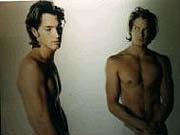 Throughout my visit to Singapore, signs of a growing gay sensibility were becoLang more boldly present that were not ventured before. Along Orchard Street’s high-end boutiques, Calvin Klein-inspired erotic/punk advertising motifs were showing up in one fashion window after another. Evocative postures, scantily garbed models and bare chested men comported in clearly sexual accents for the marketing of style.
Throughout my visit to Singapore, signs of a growing gay sensibility were becoLang more boldly present that were not ventured before. Along Orchard Street’s high-end boutiques, Calvin Klein-inspired erotic/punk advertising motifs were showing up in one fashion window after another. Evocative postures, scantily garbed models and bare chested men comported in clearly sexual accents for the marketing of style.
 Within this spectrum of suggestive homoerotic motifs was a Levi’s image of a bare chested young man in 501’s, hands tugging on a lowered belt line as he looked at another similarly clad man standing nearby. The caption behind them says, "Are you straight?" in bold print, along with smaller letters asking "Very loose? Too tight? Very relaxed?–Levi’s".
Within this spectrum of suggestive homoerotic motifs was a Levi’s image of a bare chested young man in 501’s, hands tugging on a lowered belt line as he looked at another similarly clad man standing nearby. The caption behind them says, "Are you straight?" in bold print, along with smaller letters asking "Very loose? Too tight? Very relaxed?–Levi’s".
A High Party
"Oh yes, we see it everywhere–isn’t it wonderful!" exclaimed Stan, a pharmacist, whom I met the next night. As I talked to him I was also looking at the glittering night cityscape through the floor-to-ceiling windows of a 14th floor upscale condo. In my ears, the sounds of too many people crowded into too small a space trying to talk above the Canto-pop music. My conversation is drowned out.
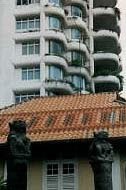 It’s called a party. Across the sofas and chairs and on to the polished parquet floor were sprawled the arms and legs of dozens of younger gay and lesbian friends and their guest. Most knew one another as evident from the energy and postures. Certain groups huddled in threes or fours to share stories and gossip; other twosomes sat very close talking seriously into each other’s ears; others, like Stan, mingled restlessly from one pod to another, hugging and kissing.
It’s called a party. Across the sofas and chairs and on to the polished parquet floor were sprawled the arms and legs of dozens of younger gay and lesbian friends and their guest. Most knew one another as evident from the energy and postures. Certain groups huddled in threes or fours to share stories and gossip; other twosomes sat very close talking seriously into each other’s ears; others, like Stan, mingled restlessly from one pod to another, hugging and kissing.
Despite some liquor and a bit of pot, no one was indiscrete–no one too drunk or too high. No overt sexual behavior. It was mostly laughter and camaraderie. Fashionably late, Francis staged a bit of an entrance with his black boa followed by his devoted boyfriend. The occasion for the party was for Stan’s friend Lang who’s leaving soon to study in London for two years. After a while Lang has lost some of his Singaporean restraint. As I moved into the den, I heard a phone ring and Patrick pulled out his cell phone to give directions to some lost partygoers.
Several Americans and Singaporeans had told me that there was no gay scene in this prosperous Asian city-state. So what was I looking at, listening to and bumping against? Clearly the assessment was wrong.
A Scene of its Own
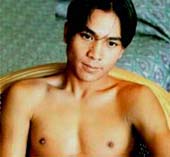 A few days later as I headed to the National Museum I came upon the open glass doors of MPH Bookstore, a large shop laid out with rich wood interiors, soft carpeting and a cafe. I inquired at the desk if they had a gay or lesbian section. Expecting a moment of awkwardness for the gray-haired clerk, she instead directed me quite politely to a younger male clerk who was only too happy to show me where they shelved such books. Past the fiction section first, then the nonfiction shelves and then to some glossy photo-art books of male nudes by Herbert List and R V Lebeauprin. Pretty.
A few days later as I headed to the National Museum I came upon the open glass doors of MPH Bookstore, a large shop laid out with rich wood interiors, soft carpeting and a cafe. I inquired at the desk if they had a gay or lesbian section. Expecting a moment of awkwardness for the gray-haired clerk, she instead directed me quite politely to a younger male clerk who was only too happy to show me where they shelved such books. Past the fiction section first, then the nonfiction shelves and then to some glossy photo-art books of male nudes by Herbert List and R V Lebeauprin. Pretty.
The lesbigay selection was not large, perhaps two dozen, all imported from the States, Europe and Australia. No gay magazines, including the fleshed-out OG magazine that is discretely based here in Singapore (but no one was supposed to know that at the time). But even this modest offering was surprising since homosexuality is a distinct criminal offence in this city-state run by autocrats with left-over Victorian notions about sex in private. More recently, Borders Books also has been offering a reasonable selection of lesbigay literature.
 Section 377 of the Penal Code clearly states the commission of any act of gross indecency between men "shall be punished with imprisonment for a term which may extend to 2 years", regardless if the contact is consentual and in private.
Section 377 of the Penal Code clearly states the commission of any act of gross indecency between men "shall be punished with imprisonment for a term which may extend to 2 years", regardless if the contact is consentual and in private.
Curiously, there is no mention of woman-to-woman sexual contact. But this doesn’t suggest its legality. Rather, more unfortunately, it reflects the historical insignificance of women’s’ stature in the culture. Surely women couldn’t have such base desires–or so thought the framers of this outdated code. The law here is a sword that also insults with silence.
The American’s assessment was further disproved when I was directed to the beach at the end of Fort Road. There was certainly no secret here as I watched single men in the late afternoon roam the dunes and bushes or languish in tiny bikinis on the sand. It looked quite similar to other sandy hunting grounds, from Key West to P’town to Black’s Beach (San Diego) to San Francisco. Certain ‘fundamental’ rituals don’t change
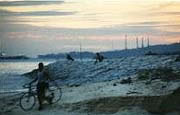 A couple of days later, Roland walked me to the Crossroads Cafe. As we sat over coffee and tea, he waved his hand merrily indicating we were on the "gay walk", where singles come to be seen with their latest fashion in men and clothes.
A couple of days later, Roland walked me to the Crossroads Cafe. As we sat over coffee and tea, he waved his hand merrily indicating we were on the "gay walk", where singles come to be seen with their latest fashion in men and clothes.
After only four days here, it was clear that a visible gay presence had taken hold in Singapore, even if it was not as clearly organized.
Yawning Bread and a Shifting Paradigm
The clearest voice of gay Singapore, on the other hand, is that of Alex Au, a businessman by day and brilliant writer and social critic at night. Several years ago he started his own website to express his thoughts and observations about the foibles and facts of his native culture. Last year he attempted to hold an ‘official’ (registered with the government) seminar on homosexuality but it was cancelled when the authorities rejected its application.
Today, after countless thought-provoking and insightful essays, his Yawning Bread web site is the most respected and incisive place on the Net for uncovering the core of Singapore’s political and cultural verities–gay, straight and in between.
In the following analysis of what I see as a shifting social paradigm in Singapore, I am grateful for Alex’s perceptive writings and correspondence in helping me to discern these important palpable changes that have become visible in the last decade of the 20th century.
Forces of Tradition and Forces of Change
Singapore may well be considered a litmus test of traditional Asian values confronting a new age of individualistic self-expression. The under-thirty generation of men and women– in Singapore, Hong Kong, Bangkok, Taipei and Manila, Shanghai–are for the first time questioning the absoluteness of traditions that subtract out personal will and personal identity. It is probably the first time in Asian history that anyone has been willing to challenge this long-standing ‘cultural imperialism’.
For countless generations, at least four powerful forces have unquestionably controlled the lives of Asians. (1) Heterosexual monogamous marriage; (2) bearing of descendants, (3) personal subjection to family cohesion, social habits and religious rituals; and (4) closed role-assignments within the multigenerational family system (child, worker, elder). Personal choice and individual self-determination have been diminished without serious challenge for as long as history has been written here.
Within the past decade of the nineties, certain unique forces, nonexistent in previous generations, have started to infuse these old insular traditions. There is now a groundswell of perceptible change in this imbalance between unquestioned conformity and individual assertion.
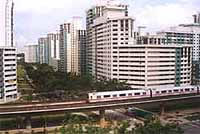 These certain forces are: (1) the emergence of middle class prosperity (increasing independence, political power, and financial influence); (2) expanded education (often abroad at western universities); (3) more frequent travel; (4) rapid international communication via the media, TV and especially the Internet; (5) increasing media freedom; and, (6) not insignificantly, the push for universal human rights which has entered the international political vocabulary in the past generation (due to efforts by groups such as the Nobel Prize winning Amnesty International as well as the Asiawatch rights organization).
These certain forces are: (1) the emergence of middle class prosperity (increasing independence, political power, and financial influence); (2) expanded education (often abroad at western universities); (3) more frequent travel; (4) rapid international communication via the media, TV and especially the Internet; (5) increasing media freedom; and, (6) not insignificantly, the push for universal human rights which has entered the international political vocabulary in the past generation (due to efforts by groups such as the Nobel Prize winning Amnesty International as well as the Asiawatch rights organization).
The cumulative effect of these forces is now an enhanced collective awareness of individual dignity and personal choice as viably real and attainable entitlements for the first time.
The Great Debate–and Shift
So a great debate rages between east and west as to the value and position of individual rights versus national and cultural demands for harmony and obedience. Contrary to the Western expression of personal freedom, the eastern voice demands the limitation of personal rights for the sake of cultural continuity and political order (no matter how repressive that order may be). The history of 20th century Asia is replete with repressive governments, some of which still hold a tight grip on their countries and on the personal fates of citizens.
And in the middle–if not at the core–of this tide of change washing onto the shores of Asia is the gay ‘agenda’ with its inherent clamoring for breaking down ignorance and bigotry, for better understanding of human sexuality, for equal rights for all classes and categories of people.
In urban centers like Taipei, Singapore, Hong Kong and Bangkok, with their histories of scorn toward homosexuality, there is a changing attitude toward more open-handed tolerance. The irrational threat so feared by ruling establishments has given way to a more listening ear–or an hapless shrug–to the appearance of gay discos, magazines, newspaper articles, books, festivals, websites, TV characters. In September 2000, the Taipei government actually sponsored the gay pride festival!
Style and Tempo of Activism
In addition to the six social factors mentioned above, this emerging new level of tolerance may well have to do with the manner and style in which gay efforts present themselves to the public and the established order.
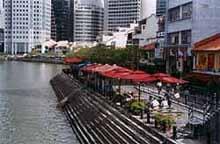 There is a noticeable lack of western-style in-your-face activism in Asian gay communities. Hong Kong’s first and only march on the government in 1997 for legalized protections was bold yet hardly threatening to the dying British authority there. (Will there be a march against the new landlord?) Singapore has yet to see such a demonstration. Even in Taipei, the government perhaps saw the virtue of supporting a gay festival and thus controlling the vehemence of the activity that took place; it all went well and the gay leaders even met with the President of Taiwan
There is a noticeable lack of western-style in-your-face activism in Asian gay communities. Hong Kong’s first and only march on the government in 1997 for legalized protections was bold yet hardly threatening to the dying British authority there. (Will there be a march against the new landlord?) Singapore has yet to see such a demonstration. Even in Taipei, the government perhaps saw the virtue of supporting a gay festival and thus controlling the vehemence of the activity that took place; it all went well and the gay leaders even met with the President of Taiwan
The effect of this gently incoLang tide has been a lack of alarm and reduced overt hostility toward gay ventures and venues and as they have appeared in such forms as live theatre, small clubs and bars, magazines and books, drag shows, commercial advertising. Newspaper coverage of gay topics is not uncommon now, even if the reports focus on ‘distant’ issue such as lesbians in America or the Gay Games in Amsterdam. A recent (1999) story in the China Daily in Shanghai informed its mostly straight readers that the Sydney Gay Games will be bigger than the Olympic Games. A 1997 lead story in the Bangkok Post covered the dramatic decision by a teacher-training college to rescind its ban on gay teachers. Human rights groups had vigorously protested, in words, the earlier anti-gay decision by the college.
HIV as an Activist Weapon
Additionally, what has kept confrontational activism at bay in Asia has been the reaction to HIV and AIDS. The pain and anger that has given so much vehemence to gay activism in the west has not been present in the major hubs of Asia. The number of cases in Asia has been much lower (though some observers dispute this), so the sense of emergency and epidemic alarm has not fired the passions or the politics of gay advocates. Thailand has often been accused of denial in its handling of HIV reality. The undeniably higher number of cases in Bangkok, especially, has resulted in severe criticism of the government, but it has also resulted in the most vigorous AIDS education program in Asia. The result of both criticism and education has been cause for a significant awareness and visibility of homosexuality and gay human rights. In 1999 Bangkok held its first out-and-loud gay pride festival and parade.
Such softer passion from gay activists also derives from a source less immediate than political offices, courtrooms or family shophouses. Homophobic gay bashing is almost unheard of in these countries. Fundamentalist aggressors do not polarize large portions of the population to vote for discriminatory statutes. Extremists do not spit on the graves of deceased young people.
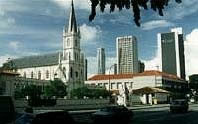 Instead of Bible-thumping tirades, a much different attitude prevails in Singapore and Asia. Two thousand years of mostly Buddhist and Confucian influence have helped shape a more compassionate disposition here that respects life in its multitude of forms. Something as unusual and puzzling as homosexuality is frowned on, is considered abnormal or bad karma, but gays are not attacked or left to die on wooden fences. Much more commonly, they are allowed to quietly to live out their karma.
Instead of Bible-thumping tirades, a much different attitude prevails in Singapore and Asia. Two thousand years of mostly Buddhist and Confucian influence have helped shape a more compassionate disposition here that respects life in its multitude of forms. Something as unusual and puzzling as homosexuality is frowned on, is considered abnormal or bad karma, but gays are not attacked or left to die on wooden fences. Much more commonly, they are allowed to quietly to live out their karma.
Families rarely throw away gay members in a heap of verbal disgust while quoting some ancient religious script. In Singapore, as in other major hubs, most gay and lesbian people do not come out to their families, but if and when they do (or more often, if the family knows without overt disclosure) they continue to live at home as part of the family.
Balance
Gays and lesbians like Roland, Stan and Alex perform a major balancing act here. The balance of gay-straight, East-West and old-new is sharpened and heated in the vortex called the ‘gay community in Asia’.
The challenge is to accept the invitation to ‘come out’ and express their validity and authentic voice. The challenge is to accept the fertile incentive of the West yet decline a cloned or alien form in order to form unique gay identities of their own–social, legal and cultural–and emerge identified as authentic Asian gays.















